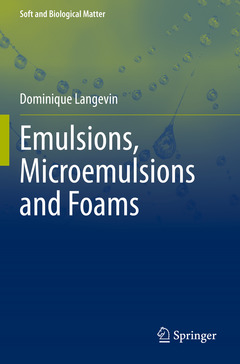Emulsions, Microemulsions and Foams, 1st ed. 2020 Soft and Biological Matter Series
Auteur : Langevin Dominique

This book takes an interface science approach to describe and understand the behavior of the dispersions we call emulsions, microemulsions and foams. The one thing all these dispersions have in common is the presence of surface-active species (surfactants) adsorbed at the interfaces between the two fluid phases that make up the emulsions, microemulsions or foams. The interfacial layers formed by the surfactants control most of the properties of the dispersions.
The book describes the properties of interfacial layers, thin films and bulk fluids used in the elaboration of the various dispersions and it explains how such properties relate to the dispersion properties of these soft matter systems: structure, rheology and stability. These dispersion properties are far from being fully understood, in particular foam and emulsion stability. In discussing the state of the art of the current knowledge, the author draws interesting parallels between emulsions, microemulsions and foams that enlighten the interpretation of previous observations and point to a deeper understanding of the behavior of these materials in the future.
· Surface tension, Contact angle, wetting
· Interface thickness: intrinsic profile, thermal fluctuations
1.2. Irreversibly adsorbed surface-active species
· Polymer layers: thickness, rheology, case of proteins
· Other species: asphaltenes, particles
· Mixed layers
1.3. Surfactant layers
· Adsorption-desorption: Gibbs description, validity of the Gibbs equation, Langmuir equation of state, energy barriers, depletion.
· Non-equilibrium systems: sorption and transfer kinetics, "dynamic" tension
· Surface rheology: extension of Gibbs description, resistance to compression and shear, viscoelasticity, Levich model, influence of the surface charge
1.4 Thin films: Interaction between surfaces (van der Waals, electrostatic, short range), disjoining pressure. Oscillatory forces, film stratification
1.5 Surfactants and self-associated systems: micelles, lyotropic liquid crystals,
· Surfactant parameter, link with HLB, HLD and PIT
· Critical micellar concentration, link with surfactant solubility, exchanges with bulk
· Micelle size distribution, micelles in organic solvents
· Lyotropic liquid crystalline phases, phase diagrams, dispersed phases (cubosomes, hexosomes)2. Microemulsions (about 40 pages)
2.1 Thermodynamic stability
· Structure, role of the spontaneous curvature and of the curvature elasticity of the surfactant layer
· Percolation· Exchanges, shape fluctuations
2.2 Phase diagrams
· Emulsification failure and other solubility limits
· “Fish” diagrams, critical points
2.3 Bicontinous microemulsions
· persistence length of the surface layer
· transition to lamellar phases or to molecularly dispersed phases
2.4 Ultralow interfacial tensions: origin, wetting phenomena
3. Emulsions and foams (about 130 pages) 3.1 Emulsion and foam structures, analogies between high internal phase emulsions (HIPE) and foams, monodisperse dispersions
3.2 Foaming and emulsification: methods, control of drop/bubble size
3.3 Foam and emulsion rheology
· Wall slip
· Soft solid behavior, rejuvenation
· Link with structural reorganisation processes, the jamming transition
· Role of interfacial rheology
3.4 Foam and emulsion stability
· Sedimentation/creaming of emulsions: influence of surface rheology, influence of surfactant concentration and of drop volume fraction. Foam drainage, case of HIPEs
· Ostwald ripening: influence of surfactant concentration and of drop volume fraction.
· Coarsening, structural reorganisation
· Coalescence of bubbles/drops
o Drainage of films between curved surfaces (Taylor/Reynolds regime), role of surface rheology, link with HLB, link with wetting. On the immobile surface condition. Dimpling instability
o Film rupture (Vrij’s model, other models)
o Coalescence of many drops (Smoluchowski model)
· Ultrastable emulsions and foams
3.5 Antifoams, defoamers, demulsifiers
4. Similarities, differences between emulsions and foams, emulsions and microemulsions.(about 30 pages)4.1 Why are bubbles larger than drops, why are emulsions longer lived than foams?
4.2 Foamed emulsions
4.3 Emulsion made with multiphase microemulsion systems 4.4 Solidification of the dispersions5. Industrial applications (about 20 pages)
5.1 Foams: detergency, food cosmetics, medicine, fire fighting, etc
5.2 Emulsions: food, cosmetics, pharmacy
5.3 Microemulsions: enhanced oil recovery, soil remediation, pharmacy, detergency
Dominique Langevin is CNRS research director. She first worked at the Physics Laboratory of Ecole Normale Superieure in Paris. She was afterwards director of the Paul Pascal Research Center, CNRS laboratory in Bordeaux. She currently works at the Laboratoire de Physique des Solides in Orsay, France.
Her main research topic is the study of liquid interfaces in the presence of surfactants, polymers and/or nanoparticles, with a special focus on interfacial rheology. She is presently involved in the study of the physical chemistry of foams and emulsions. She published about 400 articles in scientific journals. She is also active in teaching in various area of Physics: Optics, Thermodynamics and topics closer to her research, Formulation, Surfactants and Foams. She received among other awards a grand prix of the French Academy of Sciences, the silver medal of CNRS, the L’Oréal Unesco award for women in Science and the Overbeek gold medal. She is member of the Academia Europea.
Provides the fundamental interface science background for understanding emulsions, microemultions and foams
Draws new and enlightening parallels between emulsions, microemulsions and foams
Provides a brief review of the many practical applications of these dispersions, as detergents, fire retardants, medicines, cosmetics, foodstuff and more
Date de parution : 12-2021
Ouvrage de 344 p.
15.5x23.5 cm
Date de parution : 12-2020
Ouvrage de 344 p.
15.5x23.5 cm



